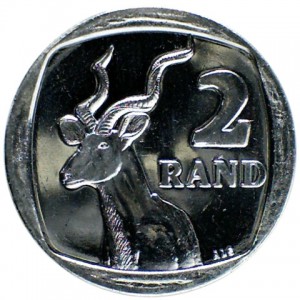South Africa’s Two Rand coin has a longer history than most people realise. Although the current nickel plated copper circulation coin was first introduced in 1989, there was an earlier, gold Two Rand coin minted every year from 1961 to 1983. This was an investment coin identical in dimension, weight and fineness to the sovereign of the pre-decimal English system. Indeed, at the time of South Africa’s currency decimalisation, two Rand was the equivalent face value of one Pound. Practically, though, the 1989 Two Rand coin was the successor to the blue Two Rand note, which it replaced in circulation.
The reverse of the coin bears an image of a male Greater Kudu, a large antelope found throughout most of sub-Saharan Africa but not, interestingly, in most of South Africa itself.
When initially released in 1989, the coin bore an image of the South African coat of arms on the obverse along with the name of the country in both Afrikaans and English, the two national languages of the time. After South Africa’s political changes, a further nine languages received official status in the country and the obverse designs of circulation coins were updated accordingly. From 1996 to 2000 the obverse of the Two Rand coin carried the same coat of arms with the name of the country written in the Xhosa language that is endemic to the Eastern Cape province. In 2000 the obverse design was changed again to depict a new coat of arms with the Xhosa legend. Both the old and the new obverse designs are found carrying the 2000 date but only the new arms were used from 2001 onwards.

South Africa’s coat of arms since 2000, with the name of the country in Afrikaans on the left and Sepedi/Sesotho on the right, on the obverse of a 2012 Two Rand coin.
In 2002, the South African Mint introduced a rotational system to allow each of the eleven national languages equal time on each coin denomination. This resulted in the Two Rand coin again carrying two languages but with these languages changing each year. Depicted here is the obverse design for 2012, bearing the name of the country in Afrikaans on the left and in Sepedi and Sesotho on the right. Although distinct from each other as languages, the words for “South Africa” are identical in Sepedi and Sesotho.
The motto beneath the coat of arms, “!KE E: |XARRA ||KE,” is written in the extinct |Xam language of the Khoisan people and means, “Diverse people unite.” This coin is therefore interesting because, in three inscriptions, it salutes four South African languages – three official and one extinct. This is also the case with the 2010 coin, which has identical inscriptions to that of 2012, and the 2009 coin, on which Sepedi and Sesotho share the obverse with the Setswana language.
Two commemorative Two Rand coins have been released into circulation since 1989. In 2004 a Two Rand coin celebrated ten years of freedom and, in 2013, another celebrated the 100th anniversary of the Union Buildings in Pretoria. Both of these circulated side by side with regular coins bearing these dates. Several other commemorative Two Rand coins have also been minted in .925 silver but none of these are circulation coins and they are seldom seen outside investment collections.
